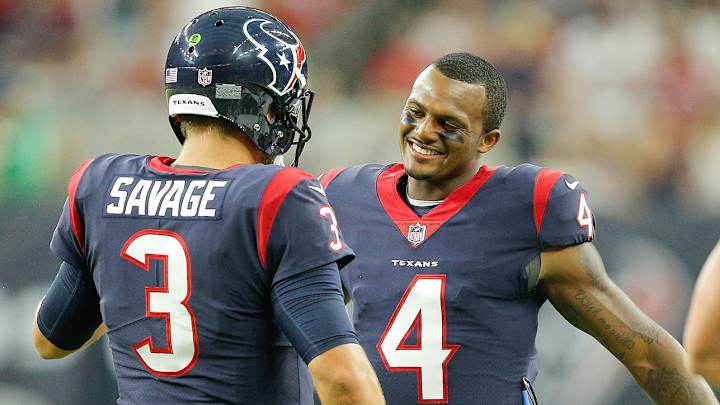Houston Texans: 10 Things You Need to Know

1. No one would be surprised if Deshaun Watson got on the field as a first-round rookie, but we shouldn’t expect it. Bill O’Brien’s offense is not easy to learn. The quarterback is responsible for a lot of checks at the line of scrimmage, and many of his reads post-snap are contingent on the coverage. The Texans run a lot of option routes underneath and choice routes downfield, with the receiver’s actions determined by where the safety is. It takes field-reading acumen and confidence to quarterback this kind of offense. Brock Osweiler never established it. Tom Savage has been here four years now and has bona fide NFL throwing traits. He has a good shot at holding onto the job all season.
2. Savage is willing to turn it loose into tight windows, which is important when your top receiver is DeAndre Hopkins. The five-year pro lacks the speed, quickness and twitch to consistently separate. But Hopkins compensates with strong hands and body control that make him the best contested-catch artist in football.

3. Hopkins is at his best working from the slot, where there’s clean access off the snap and he doesn’t have to deal with the press-jams that give him trouble. Will Fuller’s broken collarbone complicates matters, though. Without Fuller’s threatening speed on the perimeter, the Texans become limited in how they can deploy other wide receivers. Hopkins may have to play more outside, and a lot now rides on 2015 third-round pick Jaelen Strong.
Houston Texans: Should Tom Savage or Deshaun Watson Be the Starting Quarterback?
4. Lamar Miller is a good, not great, running back, but in some ways, Houston’s rushing attack is even better than its eighth-ranked 116.2 yards per game last year suggests. For starters, it’s very diverse. You see significant snaps of inside zone, outside zone and gap-scheme runs. Add-in blockers—like fullbacks and tight ends—become important here. Those blockers are also important when protecting a lead late in games, when O’Brien likes to go into heavy personnel and pound the rock. They’ve done that successfully several times over the last two years.
5. Typically, an offense with as many O-line concerns as Houston’s doesn’t run the ball well late in games. But in this case, the concerns pertain more to a lack of athleticism, which shows more in pass-blocking than run-blocking. Right tackle Chris Clark can be a major liability—and he may have to play left tackle if veteran Duane Brown continues to hold out. Inside, Jeff Allen can be slow to react (he was demoted to a rotational role down the stretch last year), while Xavier Su’a-Filo doesn’t play with enough awareness or strength.
6. This was arguably the best defense in football last season, and now it gets back arguably the best defensive player of all-time. Assistant head coach Romeo Crennel and defensive coordinator Mike Vrabel are great at using presnap alignments that create specific matchups for pass rushers. They have three guys who can’t be blocked one-on-one: J.J. Watt, Jadeveon Clowney and Whitney Mercilus.
Monday Morning QB: J.J. Watt Helps With Hurricane Harvey Flood Relief in Houston
7. Clowney is a great physical specimen and developing football player. This will be the year he fully carves out his NFL niche. He’s an explosive north/south and east/west mover. The catch is, he can only go in one direction at a time. He doesn’t have the flexibility to contort his body low and bend around the edge. That’s why, in obvious pass-rushing situations, he’s better inside than outside.
8. There may not be a more cohesive secondary than Houston’s. Defensive backs coach John Butler and assistant Anthony Midget have had mostly the same core group of players for a few years now, and the continuity that comes from that shows in how diverse and disguisable their coverages are. The foundation is Cover 4 (aka “Quarters”), which entails both safeties aligned evenly in the deep seams. This is the perfect look for rotating to a different coverage after the snap, and last season we saw a lot more Cover 2 and man-to-man concepts from Houston. That diversity will only grow in 2017. Of course, it helps to have good players. Cornerbacks Kevin Johnson, Kareem Jackson and Johnathan Joseph are all proficient in matchup schemes, and safety Andre Hal is a converted corner who provides unique coverage abilities in the middle of the field.
9. One thing the Texans do is play Cover 2 and Cover 4 when they blitz, which is unusual. Most blitzes involve Cover 1 (man-to-man with just one high safety). This structure can put a greater burden on the underneath defenders, since it leaves only two, instead of the usual three or four. Benardrick McKinney, the only linebacker in Houston’s predominant dime sub-package, sometimes gets picked on through the air. But more often than not, Houston’s five-man pass rush forces the quarterback to play on the defense’s schedule anyway.
How Do You Beat the Patriots? The Texans Have an Idea of How To Solve That Problem
10. Vince Wilfork was tremendous against the run in the first half of last season, but age crept up on him near the end. Around that time, 2016 fifth-round pick D.J. Reader elevated his game. Now Reader is sliding inside fulltime, where he’ll be Houston’s primary interior gap-plugger. He’ll have a big impact on how linebacker Brian Cushing performs.
• Question or comment? Email us at talkback@themmqb.com.
